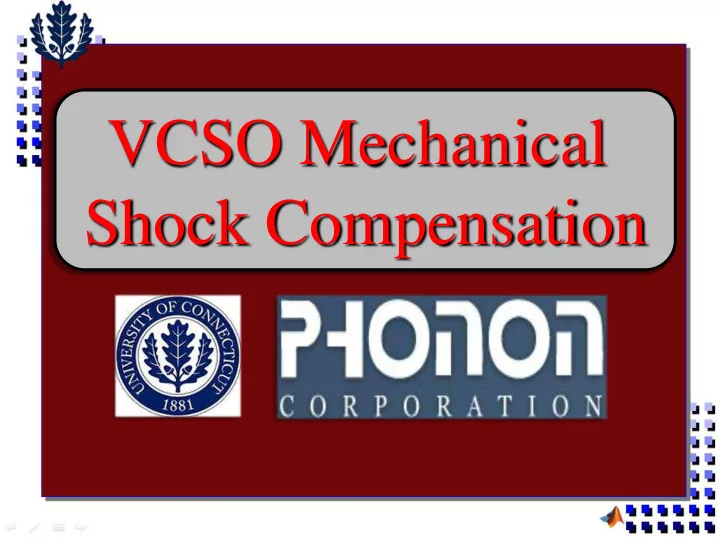

VCSO Mechanical Shock Compensation
Who are we? Team members: Max Madore Joseph Hiltz-Maher Shaun Hew Shalin Shah Advisor: Helena Silva Phonon contact: Scott Kraft
Original Goals • Measure Instantaneous Frequency shifts and compare with accelerometer voltage output • Design Compensation circuit based on frequency/voltage characteristics • Test in and implement in 3 axis to determine the unique responses of each
Previous Work Last Year: • Creation of Shock Tower for repeatable tests • Comparison of two identical VCSOs • Measurement Using Oscilloscope Problems: • Unreliable Data • Mismatched VCSO frequencies
A New Outlook • Frequency Generator allows for precise matching of generator and test VCSO • MATLAB code allows us to control Shock tower impulse, view multiple trials, filter results digitally • Better understanding of VCSO components and their reaction to shock
Project Overview • VCSO and mechanical vibration • Analog filter for compensation of 20dB • Expand compensation to three axes
Shock Tower • Uses 24V solenoid to drive a rod against a metal plate • VCSO and accelerometer sit on the plate and experience shock • Important to eliminate all erroneous vibration • Resonance • Loose parts
Signal Generator • Giga-tronics 6060B • 10kHz-1.05GHz • Provides a stable reference that can match the VCSO’s normal output
Phase Frequency Detector • Hittite HMC439QS16G • Mixes the signals from the Signal Generator and VCSO • Outputs a triangular waveform whose frequency is the difference in frequency of its inputs
Data Acquisition • National Instruments X series USB-6353 Data Acquisition Card • MATLAB 2009 on lab computer • Filtration may be desired to remove high frequency noise • Looking for changes in the hundreds of Hertz or less • Sample Rate is not fast enough to collect data directly from the VCSO or signal generator • Also used to fire the solenoid in the shock tower
Last Semester’s Results Phase frequency detector output of uncompensated shock response
Start of Spring Semester
Start of Spring Semester
Current Data
Current Data
Repeatability
Remaining Tasks
Accurately Determine Acceleration Sensitivity • Most important task to achieving compensation • Data processing and noise filtering have paid off • New accelerometers to move forward • Test each axis and superimpose compensations • Accelerometer Output Attenuation Equation: • Γ = Acceleration Sensitivity • F o = Oscillator Frequency • m = Frequency Control Curve Slope • S = Accelerometer Sensitivity
Investigate Magnitude of EM interference • Solenoid produces large EM field while shocking the VCSO • Has obvious effect on accelerometer • May also affect VCSO output
Investigate Magnitude of EM interference • Solution: Shock the VCSO manually
Secure Oscillator Firmly to Shock Tower • To remove all acceleration other than shock pulse • Currently using hand to hold oscillator • Inconsistent • Temperature • Future options: • Clamps • Cloth/Leather Strap • Introduce as little resonance as possible
Implement New Equipment • SMD capacitors and resistors for ADXL evaluation board filters • New shock tower • ADXL377 3-axis Evaluation Board • 3-axis Accelerometer/Oscillator Mount
Equipment to Buy • ADXL001-500 Evaluation boards • To replace current faulty one • To test in 3 axis • $90 each • TLC2262CP Operation Amplifiers • For 3 axis expansion • Low noise • $2.08 per chip • 2 op amps per chip
Circuits to Implement • Compensation test circuit • Potentiometers for fine tuning attenuation level • Operates around 1V on the VCSO control input • Switches to toggle compensation • Will be expanded to accommodate 3 axes • Overall gain determined by VCSO acceleration sensitivity
Circuits to Implement • Rational for 1V Operation Point: • Most linear point on the control input • Still not completely linear • Non-linearity limits compensation
Further Study If time allows: • Study delay mismatch • Isolate each element and estimate its delay • Greater delay decreases compensation • Large delay could make compensation impossible • Study other possible acceleration sensitivity factors, requiring higher filter orders • Vibration Frequency dependence • Resonance • Control Voltage • Temperature
Verification and Documentation • Verify compensation at Phonon on larger equipment • Calibrated accelerometers and vibration tables • Phase noise measurements on spectrum analyzer • Random vibration • Record compensation levels and other data • Interpret results • Compose Final Paper • Demonstrate at Senior Design Day and Phonon
Recap - Objective and Operation of Device - Tuning voltage used to regulate frequency output. - VCSO requires stable frequency output. - When VSCO is shocked the output of the device is shifted by a certain phase. - Phase instability causes frequency domain noise. - Objective is to suppress this noise with appropriate low pass filter.
Why stable frequency needed For example, in communication system a voltage control oscillator is used to create a stable frequency reference for passing information to a required frequency band. - Phase lock loop - Computer disk - Wireless electronics - Timers - Clock and data recovery
What are our Goals • Continue to improve compensation by applying digital filter in matlab • Apply 3 axis testing using triple axis mount provided by Phonon to further improve compensation if single axis compensation proves inadequate. • Design analog filter according to digital model to provide final compensation. • Test analog filter to see if compensation is in the range of 20db • Assemble conclusive thesis for final presentation.
Timeline Budget: All Equipment Provided through Phonon
Recommend
More recommend